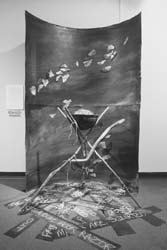Going With the Flow
The artworks of 'Watersheds, Waterwebs' raise questions about our relationship to liquid life
By Ann Elliott Sherman
TYPICALLY, AWARENESS of the local watersheds rises with impending flood levels during a wet winter, only to recede into oblivion as the waters return to their designated channels. Watersheds, Waterwebs, the new show at the Euphrat Museum of Art in Cupertino, delivers a different reminder of the critical relationship between life and water in a given habitat: an outpouring of creative efforts examining the human link in this ecological chain.
As in their past collaborative exhibitions, the Euphrat Museum and Oakland's ARTSHIP Foundation cast a broad net, gathering not only sculpture, photography and installation but also interactive software, pamphlets and documentary images created by educational activist groups such as the Aquatic Outreach Institute and Coastal Advocates.
At first glance, some of the offerings may seem more like extremely well-executed science-fair exhibits than the usual art-museum fare. Collectively, however, the inclusive strategy works. Stretching the boundaries imposed by expectation is not only a function of art but also an approach that here embodies the theme of tracing otherwise ignored connections.
Placing creative expression within the context of the bigger picture--restoring and expanding human awareness of our place within the web of life--requires the viewer to reexamine the premise that art necessarily operates in isolation from other concerns.
Which is not to say that everything on view equally succeeds in breathing spirit into those concerns. In particular, the collaborative installation 50/50: A Tale of Two Watersheds fails to tell the titular story effectively.
For the piece, Christine Arle Baeumler of Oakland and Rhoda London of St. Paul, Minn., simultaneously combed the banks of their respective waterways to collect specimens, natural and otherwise. The striking concurrence in what washed ashore hundreds of miles apart--both, for instance, found dolls' legs--is not apparent from the grid of plastic-bagged finds.
Remnants of a wooden ceremonial gate salvaged from a Russian River flood and accompanying storyboards do explain Jo Hanson's Watershed: In My Back Yard. Poster-mounted snapshots of surging, silted water and eroded banks are combined with text outlining the connection between logging, road building, development and declining fish population. The result puts her personal loss within the context of the habitat's detriment as a whole. Unfortunately, this visual scheme suffers from unavoidable associations with classroom bulletin boards, so that one wishes the valuable point could have been made in a less pedantic fashion.
SOMETIMES AN IDEA is unexpected enough that little more is needed to ignite the imagination. Lynne Hull's premise of "trans-species" art to mitigate human impact upon the environment unhinges our entire concept of art and its purpose. As a consequence, the fact that such site-specific work is unavoidably presented secondhand through documentary photographs, text and maps tucked into a canvas field kit doesn't produce the usual "guess you had to be there" response.
Through projects to restore riparian habitat by, among other things, placing sculptures to serve as nesting sites for wildlife, Hull creates art for a "client list" that includes waterfowl, raptors, reptiles, amphibians, songbirds, butterflies, bats, fish, primates--and the occasional human. As one might expect, Hull demonstrates an uncanny sensitivity in the use of forms and materials that reflect their surroundings with eloquent understatement.
Erica Fielder's Salmon Skin Cape installation juxtaposes the anthropocentric view of managing salmon populations with earlier indigenous rituals of returning the gift of the bones from the salmon catch to the water to guarantee the fishes' return. Copper wire embedded in the translucent golden cape traces the bloodstream of a wild salmon and offers an overhead view of the watershed in which it lived and died.
A placard recounts the folk tale of the Salmon Boy, driven by hunger to steal from his Forest People's salmon stores. His failure to return the bones to the river precipitates poor catches and famine that end only when he offers himself in sacrifice to the Salmon People. In a handmade book, excerpts from salmon management plans all but replace the native teaching.
Fielder's final offering sets a kettle grill piled with salmon bones on legs made of lashed tree limbs. The legs rest atop black strips of paper chalked with descriptions of cruel salmon-farm harvesting practices.
A cynic might claim Fielder has used a romanticized view of ancient wisdom as a red herring instead of examining current resource management on its own merits. But what separates Salmon Skin Cape from New Age cultural carpetbagging is the undercurrent of its larger realization: the very objectivity that justifies treating one species as a separate entity subject to man's control is just a despiritualized myth. Fielder isn't taking PC potshots; she's mourning the loss of communion with our surroundings, with all of life.
[ San Jose | Metroactive Central | Archives ]
Copyright © Metro Publishing Inc. Maintained by Boulevards New Media.
![]()

Fish Gotta Swim: Erica Fielder's mixed-media piece examines
two approaches to the harvesting of salmon.
Watersheds, Waterwebs runs through April 16 at the Euphrat Museum, De Anza College, 21250 Stevens Creek Blvd., Cupertino (408/864-8836). Through May 2 at the Creative Arts Center, 550 E. Remington, Sunnyvale. (408/730-7731; TDD/TTY 408/730-7501)
From the April 2-8, 1998 issue of Metro.
![[Metroactive Arts]](/arts/gifs/art468.gif)